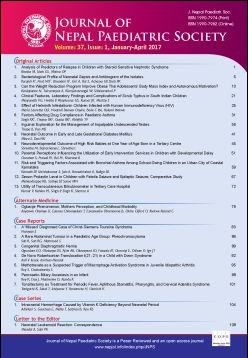Clinical Features, Laboratory Findings and Complications of Scrub Typhus in South Indian Children
DOI:
https://doi.org/10.3126/jnps.v37i1.16202Keywords:
Scrub typhus, Immune fluorescence antibody test, ChildrenAbstract
Introduction: Scrub typhus clinical features are non-specific and resemble other tropical infections like malaria, dengue and typhoid fever. Therefore appropriate gold standard laboratory tests are necessary to confirm the diagnosis of scrub typhus. Aim of this study was to determine the incidence, clinical features, laboratory data and complications of scrub typhus in South Indian Children.
Materials and Methods: Children with fever of more than seven days who were tested negative for common tropical infections were subjected to IgM-IFA for scrub typhus.
Results: Out of 857 children, 74 were eligible for IFA test. Out of these, 27(3.1%) tested positive for scrub typhus. Clinical features included hepatomegaly (96.3%), generalized lymphadenopathy (81.5%), splenomegaly (81.5%), hypotension (59.3%), rash (14.8%), eschar (7.4%), thrombocytopenia (66.7%), elevation of SGOT (85.2%) and SGPT (81.5%). Complications include hepatitis (14.8%), pneumonia (14.8%), myocarditis (14.8%) meningoencephalitis (3.7%) and MODS (3.7%).
Conclusion: Scrub typhus should be considered in the differential diagnosis of a febrile child having hepatosplenomegaly, lymphadenopathy, liver dysfunction and thrombocytopenia.
Downloads
Downloads
Additional Files
- Clinical features, laboratory findings and complications of scrub typhus in south Indian children-----Original Article
- Clinical features, laboratory findings and complications of scrub typhus in south Indian children-----Original Article
- Clinical features, laboratory findings and complications of scrub typhus in south Indian children-----Original Article
- Clinical features, laboratory findings and complications of scrub typhus in south Indian children-----Original Article
Published
How to Cite
Issue
Section
License
Authors who publish with this journal agree to the following terms:
Authors retain copyright and grant the journal right of first publication with the work simultaneously licensed under a Creative Commons Attribution License that allows others to share the work with an acknowledgement of the work's authorship and initial publication in this journal.
Authors are able to enter into separate, additional contractual arrangements for the non-exclusive distribution of the journal's published version of the work (e.g., post it to an institutional repository or publish it in a book), with an acknowledgement of its initial publication in this journal.
Authors are permitted and encouraged to post their work online (e.g., in institutional repositories or on their website) prior to and during the submission process, as it can lead to productive exchanges, as well as earlier and greater citation of published work (See The Effect of Open Access).



